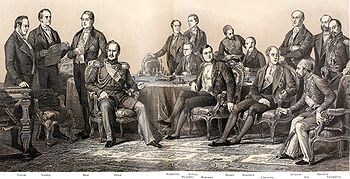- Treaty of Paris (1856)
-
For other treaties of Paris, see Treaty of Paris.
The Treaty of Paris of 1856 settled the Crimean War between Russia and an alliance of the Ottoman Empire, the British Empire, Second French Empire, and the Kingdom of Sardinia. The treaty, signed on March 30, 1856 at the Congress of Paris, made the Black Sea neutral territory, closing it to all warships, and prohibiting fortifications and the presence of armaments on its shores. The treaty marked a severe setback to Russian influence in the region.
Contents
Description
Moldavia and Wallachia would stay under nominal Ottoman rule, but would be granted independent constitutions and national assemblies, which were to be monitored by the victorious powers. A project of a referendum was to be set in place to monitor the will of the peoples regarding unification. Also, Moldavia received the south of Bessarabia (Budjak).
The treaty also demilitarised the Åland Islands in the Baltic Sea, which belonged to the autonomous Russian Grand Principality of Finland. The fortress Bomarsund had been destroyed by British and French forces in 1854 and the alliance wanted to prevent its use as a Russian military base.
The Peace of Paris confirmed Nicholas I's failures.
- Russia lost territory it had been granted at the mouth of the Danube.
- It was forced to abandon its claims to protect Christians in the Ottoman Empire in favour of France.
- Russia lost its influence over the Romanian principalities, which, together with Serbia, were given greater independence.
- Political reforms were called in Russia after they lost the war.
Signing parties
 A. Walewski
A. Walewski Bourqueney
Bourqueney Buol-Schauenstein
Buol-Schauenstein Hubner
Hubner Clarendon
Clarendon Cowley
Cowley Manteuffel
Manteuffel Hatzfeldt
Hatzfeldt Orloff
Orloff Brunnow
Brunnow Cavour
Cavour di Villamarina
di Villamarina Aali
Aali Mehemmed-Djemil
Mehemmed-Djemil
See also
- The 150th Anniversary of Demilitarisation of Åland Islands was celebrated in Finland by issuing a high value commemorative coin, the €5 150th Anniversary of Demilitarisation of Åland Islands commemorative coin, minted in 2006. The obverse depicts a pine tree, very typical in the Åland Islands. The reverse design features a boat's stern and rudder, with a dove perched on the tiller, a symbol of 150 years of peace.
- Berwick-upon-Tweed — an apocryphal story concerns Berwick's status with Russia
References
- Flagship History; Europe 1760–1871.
- (French) Edouard Gourdon, Histoire du Congrès de Paris, Paris, 1857, full text at google Print
- Some photos of the Treaty
 Treaties of the Ottoman EmpireVenetian maritime • Szeged • Constantinople (1479) • Constantinople (1533) • Franco-Ottoman • Adrianople (1547) • Amasya • Adrianople (1568) • Istanbul (1590) • Zitvatorok • Nasuh Pasha • Busza • Serav • Khotin • Zuhab • Vasvár • Buczacz • Żurawno • Bakhchisaray • Karlowitz • Constantinople (1700) • Pruth • Passarowitz • Constantinople (1724) • Ahmet Pasha • Istanbul (1736) • Belgrade • Niš • Kerden • Kuçük Kaynarca • Aynalıkavak • Sistova • Jassy • Tripoli • Tunis • Paris (1802) • Dardanalles • Bucharest • Erzurum • Akkerman • Adrianople (1829) • Constantinople (1832) • Hünkar İskelesi • Kütahya • Balta Liman • London (1840) • London (1841) • Paris (1856) • Scutari (1862) • San Stefano • Berlin (1878) • Cyprus • Tophane • Constantinople (1897) • Ouchy • London (1913) • Constantinople (1913) • Athens • Anglo-Ottoman Convention • Brest-Litovsk • Trabzon • Erzincan • Batum • Mudros • SèvresCategories:
Treaties of the Ottoman EmpireVenetian maritime • Szeged • Constantinople (1479) • Constantinople (1533) • Franco-Ottoman • Adrianople (1547) • Amasya • Adrianople (1568) • Istanbul (1590) • Zitvatorok • Nasuh Pasha • Busza • Serav • Khotin • Zuhab • Vasvár • Buczacz • Żurawno • Bakhchisaray • Karlowitz • Constantinople (1700) • Pruth • Passarowitz • Constantinople (1724) • Ahmet Pasha • Istanbul (1736) • Belgrade • Niš • Kerden • Kuçük Kaynarca • Aynalıkavak • Sistova • Jassy • Tripoli • Tunis • Paris (1802) • Dardanalles • Bucharest • Erzurum • Akkerman • Adrianople (1829) • Constantinople (1832) • Hünkar İskelesi • Kütahya • Balta Liman • London (1840) • London (1841) • Paris (1856) • Scutari (1862) • San Stefano • Berlin (1878) • Cyprus • Tophane • Constantinople (1897) • Ouchy • London (1913) • Constantinople (1913) • Athens • Anglo-Ottoman Convention • Brest-Litovsk • Trabzon • Erzincan • Batum • Mudros • SèvresCategories:- Crimean War
- Peace treaties of France
- Peace treaties of Russia
- Treaties of the Ottoman Empire
- Russo-Ottoman Wars
- 1856 in France
- Peace treaties of the United Kingdom
- 1856 treaties
- Treaties of the Russian Empire
- Treaties of the Second French Empire
Wikimedia Foundation. 2010.





